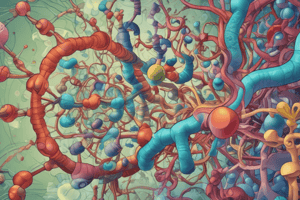Podcast
Questions and Answers
What are the three elements that make up carbohydrates?
What are the three elements that make up carbohydrates?
- Carbon, oxygen, and helium
- Hydrogen, oxygen, and nitrogen
- Carbon, hydrogen, and nitrogen
- Carbon, hydrogen, and oxygen (correct)
What is the primary function of carbohydrates in the body?
What is the primary function of carbohydrates in the body?
- To provide energy and store energy (correct)
- To regulate body temperature
- To facilitate nerve impulses
- To provide structure and support
What is the general molecular formula for monosaccharides?
What is the general molecular formula for monosaccharides?
- (CH2O)n, where n can be 3, 5, or 6 (correct)
- (C2H4O)n, where n can be 3, 5, or 6
- (CH2O)n, where n can be 2, 4, or 6
- (C3H6O)n, where n can be 3, 5, or 6
What is the classification of glyceraldehyde based on the number of carbon atoms in its molecule?
What is the classification of glyceraldehyde based on the number of carbon atoms in its molecule?
What is the molecular formula for glyceraldehyde?
What is the molecular formula for glyceraldehyde?
What is the result of oxidizing glyceraldehyde with Benedict's reagent?
What is the result of oxidizing glyceraldehyde with Benedict's reagent?
What is the name of the type of sugar that can be oxidized by Benedict's reagent?
What is the name of the type of sugar that can be oxidized by Benedict's reagent?
What is the term for molecules that have the same molecular formula but different structural formulae?
What is the term for molecules that have the same molecular formula but different structural formulae?
What is the primary characteristic of an aldose?
What is the primary characteristic of an aldose?
What is the main difference between aldoses and ketoses?
What is the main difference between aldoses and ketoses?
In which form do pentoses and hexoses exist mainly in water?
In which form do pentoses and hexoses exist mainly in water?
What is the reason why aldoses are classified as reducing sugars?
What is the reason why aldoses are classified as reducing sugars?
What is the characteristic of sugars that can react with Benedict's reagent?
What is the characteristic of sugars that can react with Benedict's reagent?
What is the significance of the classification of sugars as aldoses or ketoses?
What is the significance of the classification of sugars as aldoses or ketoses?
Study Notes
Carbohydrates
- Carbohydrates are molecular compounds made from three elements: carbon, hydrogen, and oxygen
- They can be classified into three types: monosaccharides, disaccharides, and polysaccharides
- Carbohydrates are:
- A source of energy for the body (e.g. glucose)
- A store of energy (e.g. starch in plants)
- Building blocks for polysaccharides (giant carbohydrates)
- Components of other molecules (e.g. DNA, RNA, glycolipids, glycoproteins, ATP)
Monosaccharides
- Monosaccharides are the simplest carbohydrates and are often called single sugars
- They are the building blocks from which all bigger carbohydrates are made
- They have the general molecular formula (CH2O)n, where n can be 3, 5, or 6
- Monosaccharides can be classified according to the number of carbon atoms in a molecule:
- Trioses (n = 3), e.g. glyceraldehyde
- Pentoses (n = 5), e.g. ribose and deoxyribose
- Hexoses (n = 6), e.g. fructose, glucose, and galactose
Structural Isomers
- Molecules that have the same molecular formula but different structural formulae are called structural isomers
- Examples of structural isomers include molecules with the molecular formula C5H10O5 and C6H12O6
Glyceraldehyde
- Glyceraldehyde's molecular formula is C3H6O3
- Its structural formula shows it contains an aldehyde group (-CHO) and two hydroxyl groups (-OH)
- It can also be classified as an aldose due to the presence of an aldehyde group
- It is a reducing sugar and gives a positive test with Benedict's reagent
- The aldehyde group is oxidised to a carboxylic acid and Benedict's reagent is reduced (Cu2+ to Cu+)
Classification of Monosaccharides
- Glyceraldehyde is a triose, having three carbon atoms in each molecule.
- It is also an aldose, due to the presence of an aldehyde group.
Structural Forms of Monosaccharides
- Pentoses and hexoses can exist in two forms: cyclic and non-cyclic.
- Non-cyclic forms show the presence of an aldehyde group (aldoses) or a ketone group (ketoses).
Examples of Monosaccharides
- Fructose is a ketose, containing a ketone group.
- Ribose and glucose are aldoses, containing an aldehyde group.
Characteristics of Aldoses and Ketoses
- Aldoses are reducing sugars, while ketoses are non-reducing sugars.
- This classification is important in understanding the reaction of sugars with Benedict's reagent.
Representation of Cyclic Forms
- There are three ways to represent the cyclic form: Haworth formula, chair representation, and stereo projection.
- In water, pentoses and hexoses mainly exist in the cyclic form, which is essential for forming larger saccharide molecules.
Studying That Suits You
Use AI to generate personalized quizzes and flashcards to suit your learning preferences.
Description
Understand the basics of carbohydrates, their classification into monosaccharides, disaccharides, and polysaccharides, and their roles in the body and molecules.




